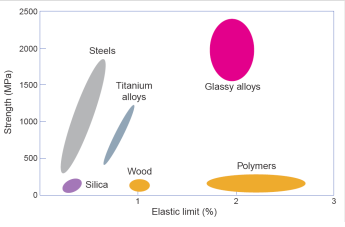Wanorde in kristallen: de rol van willekeurigheid in materiaaleigenschappen
Wanorde in kristallen: de rol van willekeurigheid in materiaaleigenschappen
Promotor(en): S. Cottenier, V. Van Speybroeck /MM_14_MAT_06 / Solid-state physicsMetallic glasses are a fascinating class of materials. They are entirely made out of metallic elements, yet structurally, they are more akin to glasses. This is caused by the way they are produced: the molten metal is quenched very quickly, leaving the atoms no time to take their positions in an ordered lattice. The material thus remains in an amorphous state, which provides the metallic glass with a range of interesting properties: they are stronger, more elastic, more oxidation resistant, ... In most cases, this is because the amorphicity does not allow for crystal defects (as there is no crystal at all). Dislocations, grain boundaries and precipitates are only a few structures which determine the properties of regular crystalline alloys. Amorphous alloys do not suffer from these effects.

Bulk metallic glasses or BMGs are the latest additions to the metallic glass family. In the 1990s, researchers discovered that some alloys could be brought into an amorphous state at much lower cooling rates. This enabled them to use conventional casting methods and produce much larger samples: metallic glasses in bulk, or bulk metallic glasses. Since that discovery, the hardest part has been the identification of suitable materials systems. Over time, a few key ingredients have been found to determine a good glass-forming material: 1) the use of many different atom types 2) the use of atoms with substantially different radii and 3) a negative enthalpy of mixing.
The enthalpy of mixing is the primary topic of interest in this Master's thesis. It is a quantity that expresses how easily atoms of one material can be introduced into a host lattice of another one. Since it relates to crystalline properties, the enthalpy of mixing allows us to perform computer simulations. Unfortunately, when impurity atoms are added to a host material, they are randomly scattered over the different lattice positions. This randomness is hard to model, but significantly influences the properties of the metallic mixture (alloy).
Goal
Your objective would be to study several state-of-the-art methods that take into account randomness and investigate how this crystalline disorder influences the properties of the material. Some of these approaches average over ensembles of quasi-randomly distributed crystals, while others try to look for one quasi-random material that mimics the disorder of real alloys best. Your calculations would be performed on a quantum physical basis, using existing software.From the viewpoint of BMGs, we are mostly interested in the effect on enthalpies of mixing, but other quantities may also vary widely between ordered and disordered crystals (such as the volume and the compressibility of the material). In addition, it is also important to take into account the effect of temperature. Most quantum mechanical approaches are limited to zero kelvin, but for real-life compounds, lattice vibrations and electronic excitations need to be included. By combining disorder and non-zero temperatures, your thesis can provide the tools to discover the BMGs of tomorrow.
This research is conducted at the Center for Molecular Modeling, in collaboration with the Department of Materials Science and Engineering. Results may moreover be discussed with experimental BMG researchers at OCAS, a joint venture between ArcelorMittal and the Flemish Region. No prior knowledge of quantum physical software is required, interested students will receive training in the necessary techniques.
- Study programmeMaster of Science in Engineering Physics [EMPHYS], Master of Science in Physics and Astronomy [CMFYST], Master of Science in Sustainable Materials Engineering [EMMAEN]

